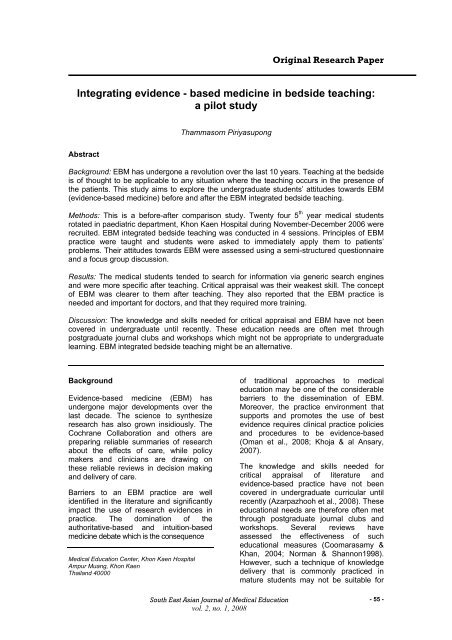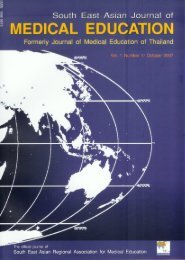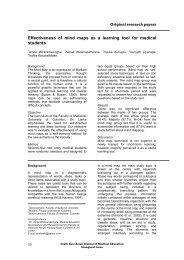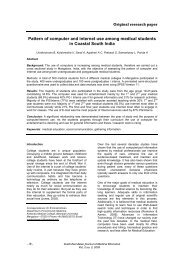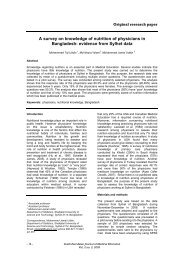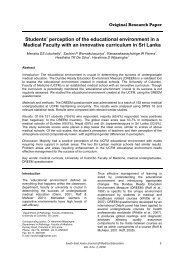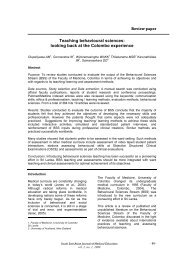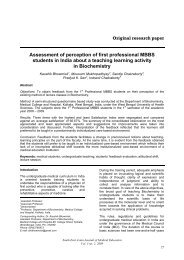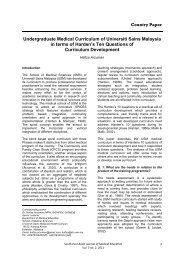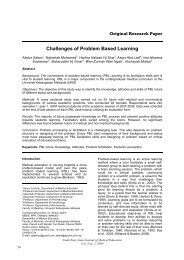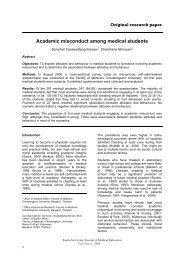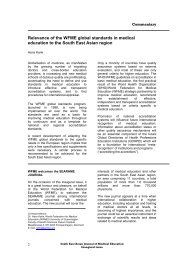Integrating evidence - based medicine in bedside teaching: a pilot ...
Integrating evidence - based medicine in bedside teaching: a pilot ...
Integrating evidence - based medicine in bedside teaching: a pilot ...
Create successful ePaper yourself
Turn your PDF publications into a flip-book with our unique Google optimized e-Paper software.
Orig<strong>in</strong>al Research Paper<br />
<strong>Integrat<strong>in</strong>g</strong> <strong>evidence</strong> - <strong>based</strong> <strong>medic<strong>in</strong>e</strong> <strong>in</strong> <strong>bedside</strong> teach<strong>in</strong>g:<br />
a <strong>pilot</strong> study<br />
Thammasorn Piriyasupong<br />
Abstract<br />
Background: EBM has undergone a revolution over the last 10 years. Teach<strong>in</strong>g at the <strong>bedside</strong><br />
is of thought to be applicable to any situation where the teach<strong>in</strong>g occurs <strong>in</strong> the presence of<br />
the patients. This study aims to explore the undergraduate students’ attitudes towards EBM<br />
(<strong>evidence</strong>-<strong>based</strong> <strong>medic<strong>in</strong>e</strong>) before and after the EBM <strong>in</strong>tegrated <strong>bedside</strong> teach<strong>in</strong>g.<br />
Methods: This is a before-after comparison study. Twenty four 5 th year medical students<br />
rotated <strong>in</strong> paediatric department, Khon Kaen Hospital dur<strong>in</strong>g November-December 2006 were<br />
recruited. EBM <strong>in</strong>tegrated <strong>bedside</strong> teach<strong>in</strong>g was conducted <strong>in</strong> 4 sessions. Pr<strong>in</strong>ciples of EBM<br />
practice were taught and students were asked to immediately apply them to patients’<br />
problems. Their attitudes towards EBM were assessed us<strong>in</strong>g a semi-structured questionnaire<br />
and a focus group discussion.<br />
Results: The medical students tended to search for <strong>in</strong>formation via generic search eng<strong>in</strong>es<br />
and were more specific after teach<strong>in</strong>g. Critical appraisal was their weakest skill. The concept<br />
of EBM was clearer to them after teach<strong>in</strong>g. They also reported that the EBM practice is<br />
needed and important for doctors, and that they required more tra<strong>in</strong><strong>in</strong>g.<br />
Discussion: The knowledge and skills needed for critical appraisal and EBM have not been<br />
covered <strong>in</strong> undergraduate until recently. These education needs are often met through<br />
postgraduate journal clubs and workshops which might not be appropriate to undergraduate<br />
learn<strong>in</strong>g. EBM <strong>in</strong>tegrated <strong>bedside</strong> teach<strong>in</strong>g might be an alternative.<br />
Background<br />
Evidence-<strong>based</strong> <strong>medic<strong>in</strong>e</strong> (EBM) has<br />
undergone major developments over the<br />
last decade. The science to synthesize<br />
research has also grown <strong>in</strong>sidiously. The<br />
Cochrane Collaboration and others are<br />
prepar<strong>in</strong>g reliable summaries of research<br />
about the effects of care, while policy<br />
makers and cl<strong>in</strong>icians are draw<strong>in</strong>g on<br />
these reliable reviews <strong>in</strong> decision mak<strong>in</strong>g<br />
and delivery of care.<br />
Barriers to an EBM practice are well<br />
identified <strong>in</strong> the literature and significantly<br />
impact the use of research <strong>evidence</strong>s <strong>in</strong><br />
practice. The dom<strong>in</strong>ation of the<br />
authoritative-<strong>based</strong> and <strong>in</strong>tuition-<strong>based</strong><br />
<strong>medic<strong>in</strong>e</strong> debate which is the consequence<br />
Medical Education Center, Khon Kaen Hospital<br />
Ampur Muang, Khon Kaen<br />
Thailand 40000<br />
of traditional approaches to medical<br />
education may be one of the considerable<br />
barriers to the dissem<strong>in</strong>ation of EBM.<br />
Moreover, the practice environment that<br />
supports and promotes the use of best<br />
<strong>evidence</strong> requires cl<strong>in</strong>ical practice policies<br />
and procedures to be <strong>evidence</strong>-<strong>based</strong><br />
(Oman et al., 2008; Khoja & al Ansary,<br />
2007).<br />
The knowledge and skills needed for<br />
critical appraisal of literature and<br />
<strong>evidence</strong>-<strong>based</strong> practice have not been<br />
covered <strong>in</strong> undergraduate curricular until<br />
recently (Azarpazhooh et al., 2008). These<br />
educational needs are therefore often met<br />
through postgraduate journal clubs and<br />
workshops. Several reviews have<br />
assessed the effectiveness of such<br />
educational measures (Coomarasamy &<br />
Khan, 2004; Norman & Shannon1998).<br />
However, such a technique of knowledge<br />
delivery that is commonly practiced <strong>in</strong><br />
mature students may not be suitable for<br />
South East Asian Journal of Medical Education<br />
vol. 2, no. 1, 2008<br />
- 55 -
the undergraduate student (Azarpazhooh<br />
et al., 2008).<br />
Teach<strong>in</strong>g at the <strong>bedside</strong> is thought to be<br />
applicable to any situation where the<br />
teach<strong>in</strong>g occurs <strong>in</strong> the presence of the<br />
patient (Jenk<strong>in</strong>s et al., 2007; Yusuf, 2005).<br />
Moreover, this method of teach<strong>in</strong>g has a<br />
potential to improve EBM practice and<br />
subsequently, the quality of care for<br />
patients. This study, thus aims to explore<br />
the understand<strong>in</strong>g and attitudes of<br />
undergraduate students towards the EBM<br />
<strong>in</strong>tegrated <strong>bedside</strong> teach<strong>in</strong>g.<br />
Material and Methods<br />
Study design<br />
This is a before-after comparison <strong>pilot</strong><br />
study to explore the attitudes of<br />
undergraduate medical students towards<br />
EBM before and after EBM <strong>in</strong>tegrated<br />
<strong>bedside</strong> teach<strong>in</strong>g.<br />
Participants<br />
Twenty four of 5 th year medical students<br />
rotated <strong>in</strong> Paediatric department, Khon<br />
Kaen Hospital dur<strong>in</strong>g November-<br />
December 2006 were recruited.<br />
Procedure<br />
The selected students were allocated<br />
equally <strong>in</strong>to 4 groups. EBM <strong>in</strong>tegrated<br />
<strong>bedside</strong> teach<strong>in</strong>g was conducted <strong>in</strong> 4<br />
sessions which lasted approximately 1-1.5<br />
hours for each. The pr<strong>in</strong>ciples of practice<br />
of EBM were taught and asked the<br />
students were requested to put them to<br />
practice at each session.<br />
Intervention<br />
At each session, one of four pr<strong>in</strong>ciples of<br />
EBM practice was taught, the concept of<br />
each pr<strong>in</strong>ciple be<strong>in</strong>g <strong>in</strong>troduced<br />
didactically at the beg<strong>in</strong>n<strong>in</strong>g of the<br />
session. Students were then encouraged<br />
to do group practice immediately<br />
afterward. All of the steps were performed<br />
regard<strong>in</strong>g patients’ problems that arose<br />
dur<strong>in</strong>g the <strong>bedside</strong> teach<strong>in</strong>g <strong>in</strong> each<br />
session. The four steps (pr<strong>in</strong>ciples) of<br />
EBM <strong>in</strong>cluded:<br />
(i) Formulate an answerable question<br />
(ii) Track down the best <strong>evidence</strong><br />
(iii) Critically appraise the <strong>evidence</strong><br />
(iv) Integrate with cl<strong>in</strong>ical expertise and<br />
patient values<br />
Ma<strong>in</strong> outcome measures and<br />
questionnaire adm<strong>in</strong>istered<br />
Newly developed and <strong>pilot</strong>ed semistructured<br />
questionnaires were distributed<br />
and students were asked to fill <strong>in</strong> the<br />
questionnaire before and then after the<br />
conclusion of 4 sessions.<br />
The questionnaire covered the follow<strong>in</strong>g<br />
areas<br />
1. Resources where student used to<br />
access EBM<br />
2. Confidence of us<strong>in</strong>g accessed<br />
<strong>in</strong>formation<br />
3. Attitudes of EBM <strong>in</strong>tegrated <strong>bedside</strong><br />
teach<strong>in</strong>g <strong>in</strong>clud<strong>in</strong>g satisfaction<br />
4. Conflicts arisen from EBM practic<strong>in</strong>g<br />
5. Idea about EBM <strong>in</strong>tegrated <strong>bedside</strong><br />
teach<strong>in</strong>g<br />
Moreover, a group of 6 medical students<br />
who reported that EBM was not necessary<br />
to medical students were asked to enroll <strong>in</strong><br />
the focus group discussion to confer their<br />
attitude about practic<strong>in</strong>g EBM. A time and<br />
venue comfortable to the students was<br />
arranged. Broad questions about EBM<br />
practice were <strong>in</strong>itially discussed. Students<br />
were encouraged to talk openly and<br />
<strong>in</strong>formally along with appropriate probes to<br />
encourage participant elaboration and<br />
clarification. Projective question<strong>in</strong>g<br />
procedures will be used to tap emotional<br />
responses. All the discussions were taped<br />
recorded and then transcribed. A brief<br />
presentation was fed back to the group for<br />
verification of data given by them.<br />
The group discussion lasted approximately<br />
1 hour, and all were moderated by an<br />
<strong>in</strong>vestigator. The students were<br />
encouraged to have a genu<strong>in</strong>e discussion,<br />
talk<strong>in</strong>g between themselves rather than<br />
address<strong>in</strong>g all their remarks to the<br />
moderator. However, steps were taken to<br />
create an atmosphere of mutual trust and<br />
respect. This ensured that <strong>in</strong>dividuals<br />
stayed with<strong>in</strong> the whole-group discussion,<br />
that the moderator can <strong>in</strong>tervene to probe<br />
and move the discussion on when<br />
necessary, and that <strong>in</strong>terruptions and<br />
<strong>in</strong>stances of more than one person talk<strong>in</strong>g<br />
at a time were kept to a m<strong>in</strong>imum.<br />
Pilot<strong>in</strong>g of the questionnaire<br />
The <strong>pilot</strong> study was conducted with up to<br />
20 <strong>in</strong>terns to check for the completeness<br />
of the questionnaire. This took approximately<br />
- 56 -<br />
South East Asian Journal of Medical Education<br />
vol. 2, no. 1, 2008
2 weeks to complete. Problems related to<br />
word<strong>in</strong>g of the questions, frame of<br />
reference, description <strong>in</strong> the questionnaire<br />
that occurred dur<strong>in</strong>g the <strong>pilot</strong> study were<br />
recorded. The questionnaires were, then,<br />
revised. After <strong>pilot</strong><strong>in</strong>g, the f<strong>in</strong>al version of<br />
questionnaire was produced.<br />
Data analysis<br />
Quantitative analysis<br />
All participants were assessed on their<br />
attitudes and understand<strong>in</strong>g of EBM just<br />
prior to the first session us<strong>in</strong>g the semistructured<br />
questionnaire. At the end of the<br />
fourth session their attitudes and<br />
understand<strong>in</strong>g of EBM were re-assessed.<br />
SPSS (Version 15.0) software programme<br />
was used for statistical analysis.<br />
Frequency tables will be presented<br />
together with percentages while mean<br />
values and standard deviations will be<br />
shown if appropriate. Parameters will be<br />
tested uni-variately for difference between<br />
pre- and post-test group. Parameters were<br />
classified and then tested if applicable.<br />
Comparison of the two groups was<br />
performed us<strong>in</strong>g Pearson’s chi-square<br />
Test. P values < 0.05 were considered<br />
significant.<br />
Qualitative analysis<br />
The focus group discussion was audio<br />
taped for later transcription with the<br />
permission from the students. The content<br />
was analysed to identify trends and<br />
patterns that reappear with<strong>in</strong> the focus<br />
group. Data were coded <strong>in</strong>dependently by<br />
2 research assistants to <strong>in</strong>crease the<br />
reliability of the study.<br />
The transcripts formed the ‘raw data’ for<br />
analysis, along with notes made by<br />
researcher dur<strong>in</strong>g and immediately after<br />
the discussions. Transcripts were<br />
analyzed us<strong>in</strong>g a thematic <strong>in</strong>dex<strong>in</strong>g and<br />
chart<strong>in</strong>g system – a form of qualitative<br />
cod<strong>in</strong>g and thematic sort<strong>in</strong>g often known<br />
as ‘Framework’. This method <strong>in</strong>volved<br />
creat<strong>in</strong>g an <strong>in</strong>dex or code frame of<br />
substantive themes and chart<strong>in</strong>g key<br />
f<strong>in</strong>d<strong>in</strong>gs with<strong>in</strong> each theme, systematically<br />
cod<strong>in</strong>g up transcripts for key po<strong>in</strong>ts and<br />
illustrative verbatim comments. F<strong>in</strong>d<strong>in</strong>gs<br />
on the key themes for each group were<br />
then summarized on a chart <strong>in</strong>corporat<strong>in</strong>g<br />
the key verbatim.<br />
The chart<strong>in</strong>g method was used to ensure<br />
analysis of the data was rigorous,<br />
balanced and accurate, allow<strong>in</strong>g the<br />
themes and hypotheses developed <strong>in</strong>itially<br />
to be ref<strong>in</strong>ed after a review of the<br />
<strong>evidence</strong>. The researcher was very careful<br />
at all stages to look for quotes to support<br />
both sides of any given argument, rather<br />
than only those statements which<br />
appeared to support <strong>in</strong>itial hypotheses.<br />
The discussions were written up to provide<br />
a detailed and accurate overview of the<br />
key themes and f<strong>in</strong>d<strong>in</strong>gs. Quotes from<br />
<strong>in</strong>dividuals have been chosen to illustrate<br />
the range of viewpo<strong>in</strong>ts on each theme.<br />
Ethical approval<br />
This study has been approved by the<br />
Ethics Committee for Research <strong>in</strong><br />
Humans, Khon Kaen Hospital.<br />
Results<br />
There were 24 fifth year medical students<br />
<strong>in</strong> this study; 11 were male and 13 were<br />
female. Their ages were similar across the<br />
group with an average of 23 years, and<br />
their mean grade po<strong>in</strong>t average (GPA)<br />
was 3.21 (maximum=4). At the time of<br />
delivery of the EBM <strong>in</strong>tegrated <strong>bedside</strong><br />
teach<strong>in</strong>g dur<strong>in</strong>g November to December<br />
2006, they were <strong>in</strong> the second half of the<br />
academic year 2006.<br />
In relation to sources of medical<br />
knowledge for medical student, the first 3<br />
frequently used by the students were<br />
standard textbooks, <strong>in</strong>ternet and<br />
consultation with senior doctors or medical<br />
staff (see Table 1) both before and after<br />
teach<strong>in</strong>g EBM. However, what we have<br />
observed was that they tended to search<br />
via generic search eng<strong>in</strong>e such as google<br />
or yahoo search before teach<strong>in</strong>g and more<br />
specific to medical search<strong>in</strong>g such as<br />
us<strong>in</strong>g pubmed after teach<strong>in</strong>g.<br />
Most of them have reported that they have<br />
heard about EBM s<strong>in</strong>ce they were <strong>in</strong> the<br />
fourth year, but not quite clear about the<br />
mean<strong>in</strong>g and method of perform<strong>in</strong>g EBM<br />
practice. Thus, at the time before teach<strong>in</strong>g<br />
EBM <strong>in</strong>tegrated <strong>bedside</strong> teach<strong>in</strong>g, they<br />
were not confidence about EBM practice.<br />
However, after the 4 sessions of teach<strong>in</strong>g,<br />
the concept of EBM was clearer, and need<br />
more opportunities to practice to ga<strong>in</strong> their<br />
confidence. After teach<strong>in</strong>g, most of them<br />
stated that critical appraisal was their<br />
weakest skill followed by search<strong>in</strong>g skill.<br />
South East Asian Journal of Medical Education<br />
vol. 2, no. 1, 2008<br />
- 57 -
Table 1: Sources of medical knowledge reported by the medical students<br />
Sources of medical knowledge Before teach<strong>in</strong>g (n=24) After teach<strong>in</strong>g (n=24)<br />
Most frequently used: N<br />
Standard Textbook 10 10<br />
Internet search<strong>in</strong>g 8 10<br />
Consultation with senior staff 6 4<br />
Most updated: N<br />
Standard Textbook 6 6<br />
Internet search<strong>in</strong>g 10 14<br />
Consultation with senior staff 8 4<br />
Most reliable: N<br />
Standard Textbook 12 12<br />
Internet search<strong>in</strong>g 8 4<br />
Consultation with senior staff 4 8<br />
Most convenient: N<br />
Standard Textbook 10 9<br />
Internet search<strong>in</strong>g 6 8<br />
Consultation with senior staff 8 7<br />
Most suitable for daily access: N<br />
Standard Textbook 12 10<br />
Internet search<strong>in</strong>g 8 5<br />
Consultation with senior staff 4 9<br />
The students <strong>in</strong>formed that EBM practice<br />
was important and required to be<br />
<strong>in</strong>tegrated <strong>in</strong>to the curricular. However, six<br />
of them stated that EBM was unnecessary<br />
for the medical student. Dur<strong>in</strong>g the period<br />
of teach<strong>in</strong>g, some of them reported of<br />
hav<strong>in</strong>g conflicted between the real practice<br />
they had observed <strong>in</strong> wards and what they<br />
found <strong>in</strong> updated literatures which required<br />
more clarification for them.<br />
For those who said that EBM was<br />
unnecessary for medical students, they<br />
were asked to jo<strong>in</strong> the focus group for the<br />
discussion.<br />
After the exploration of their attitudes,<br />
some limitations for the medical students<br />
about practic<strong>in</strong>g EBM were raised. This<br />
<strong>in</strong>cluded limitation of time, resources and<br />
required skill (e.g. appraisal and search<strong>in</strong>g<br />
skills). Some of their comments are listed<br />
verbatim <strong>in</strong> Box 1. Students found EBM<br />
<strong>in</strong>tegrated <strong>bedside</strong> teach<strong>in</strong>g, relatively<br />
pragmatic as it has shown the practical<br />
approach to patients’ problems us<strong>in</strong>g<br />
EBM.<br />
- 58 -<br />
South East Asian Journal of Medical Education<br />
vol. 2, no. 1, 2008
Box 1: Verbatim from the medical student about EBM<br />
“I know that it (EBM) is important, but we (medical students) don’t have time, what I can do right<br />
now is just to mange to survive day by day”<br />
“I th<strong>in</strong>k textbooks are already enough for us (medical students)”<br />
“I th<strong>in</strong>k it (EBM) is too difficult, I don’t know how to critique, how to do search<strong>in</strong>g. If I do it wrong,<br />
then I will waste my time”<br />
“I th<strong>in</strong>k the idea (about EBM) is good, but I don’t th<strong>in</strong>k we (medical students) can it everyday”<br />
“I will be better to have someone to conclude everyth<strong>in</strong>g for us, but I don’t th<strong>in</strong>k we can have one”<br />
Discussion and conclusion<br />
The objective of this <strong>pilot</strong> study was to<br />
demonstrate the attitudes of medical<br />
students towards EBM. It has also shown<br />
that it is possible to teach EBM at the<br />
<strong>bedside</strong> dur<strong>in</strong>g ward rounds From this<br />
study, we can observe the change <strong>in</strong> the<br />
way they search medical literatures. In<br />
relation to practice EBM, the students<br />
were still not confident about apprais<strong>in</strong>g<br />
and search<strong>in</strong>g for <strong>evidence</strong>, and this<br />
suggested the need for more tra<strong>in</strong><strong>in</strong>g.<br />
Aside from the above, this study also<br />
identified the possibility to deliver the<br />
concept of EBM to undergraduate<br />
students by encourag<strong>in</strong>g them to use all<br />
relevant medical knowledge resources to<br />
answer patients’ problems. However, with<br />
time limitation of teach<strong>in</strong>g, the<br />
susta<strong>in</strong>ability of EBM practice <strong>in</strong> this group<br />
of students was still questionable.<br />
Moreover, despite the short duration of<br />
teach<strong>in</strong>g, conflicts between updated<br />
literature and real practice can be<br />
observed by the students and this might<br />
cause confusion for them, as we know that<br />
traditional approaches to medical<br />
education may be one of the considerable<br />
barriers to the dissem<strong>in</strong>ation of EBM<br />
(Yousefi-Nooraie et al., 2007).<br />
Apprais<strong>in</strong>g and search<strong>in</strong>g skills were the<br />
students’ weakest skill, this has the same<br />
op<strong>in</strong>ion with some experts who suggested<br />
that <strong>in</strong>troductory EBM courses should be<br />
simple and certa<strong>in</strong> topics such as critical<br />
appraisal and statistical methods should<br />
be left to advanced courses (Yousefi-<br />
Nooraie et al., 2007b). This is confirmed<br />
by another study where most cl<strong>in</strong>icians<br />
stated that EBM was important for cl<strong>in</strong>ical<br />
practice. However, biostatistics was still<br />
found to be challeng<strong>in</strong>g (West & Ficalora,<br />
2007).<br />
From the student verbatim, their workload<br />
was considered as the ma<strong>in</strong> obstacles to<br />
practice EBM which also agree with one<br />
study which have stated that workload and<br />
resources such as library were needed to<br />
achieved EBM practice 2 . another issue to<br />
bear <strong>in</strong> m<strong>in</strong>d is that each cl<strong>in</strong>ical problem<br />
is different, and the resources available to<br />
solve each problem can be varied. student<br />
must search for the best <strong>evidence</strong> but<br />
understand that <strong>in</strong> some circumstances<br />
there may be no good <strong>evidence</strong> to support<br />
cl<strong>in</strong>ical judgment (Coll<strong>in</strong>s, 2007).<br />
In conclusion, EBM <strong>in</strong>tegrated <strong>bedside</strong><br />
teach<strong>in</strong>g may be an alternative to journal<br />
clubs or workshops for teach<strong>in</strong>g EBM to<br />
undergraduate medical students.<br />
However, regular course throughout the<br />
cl<strong>in</strong>ical years and supervision from skilled<br />
staff are also required. The process of<br />
EBM practice should also be promoted<br />
iteratively.<br />
Acknowledgement<br />
The author thanks the Medical Education<br />
Center and medical staff at the<br />
Department of Paediatrics, Khon Kaen<br />
Hospital for their dedication to patient care<br />
and education. The author also<br />
South East Asian Journal of Medical Education<br />
vol. 2, no. 1, 2008<br />
- 59 -
acknowledges the Research Committee of<br />
the Khon Kaen Hospital for its support and<br />
encouragement.<br />
References<br />
Azarpazhooh, A., Mayhall, J.T. & Leake, J.L. (2008)<br />
Introduc<strong>in</strong>g dental students to <strong>evidence</strong>-<strong>based</strong><br />
decisions <strong>in</strong> dental care, Journal of Dental Education,<br />
72(1), 87-109.<br />
Coll<strong>in</strong>s, J. (2007) Evidence-<strong>based</strong> <strong>medic<strong>in</strong>e</strong>, Journal<br />
of American College of Radiology, 4(8), 551-4.<br />
Coomarasamy, A. & Khan, K.S. (2004) What is the<br />
<strong>evidence</strong> that postgraduate teach<strong>in</strong>g <strong>in</strong> <strong>evidence</strong><br />
<strong>based</strong> <strong>medic<strong>in</strong>e</strong> changes anyth<strong>in</strong>g A systematic<br />
review, British Medical Journal, 329(7473), 1017.<br />
Jenk<strong>in</strong>s, C., Page, C., Hewamana, S. & Brigley, S.<br />
(2007) Techniques for effective <strong>bedside</strong> teach<strong>in</strong>g,<br />
British Journal of Hospital Medic<strong>in</strong>e (London), 68(9),<br />
M150-153.<br />
Khoja, T.A. & Al-Ansary, L.A. (2007) Attitudes to<br />
<strong>evidence</strong>-<strong>based</strong> <strong>medic<strong>in</strong>e</strong> of primary care physicians<br />
<strong>in</strong> Asir region, Saudi Arabia. East Mediterranean<br />
Health Journal, 13(2), 408-419.<br />
Norman, G.R. & Shannon, S.I. (1998) Effectiveness<br />
of <strong>in</strong>struction <strong>in</strong> critical appraisal (<strong>evidence</strong>-<strong>based</strong><br />
<strong>medic<strong>in</strong>e</strong>) skills: a critical appraisal. Canadian<br />
Medical Association Journal;158(2), 177-181.<br />
Oman, .K.S., Duran, C. & F<strong>in</strong>k, R. (2008) Evidence<strong>based</strong><br />
policy and procedures: an algorithm for<br />
success, Journal of Nurs<strong>in</strong>g Adm<strong>in</strong>istration, 38(1),<br />
47-51.<br />
West, C.P. & Ficalora, R.D. (2007) Cl<strong>in</strong>ician attitudes<br />
toward biostatistics. Mayo Cl<strong>in</strong>ical Procedures, 82(8),<br />
939-943.<br />
Yousefi-Nooraie, R., Shakiba, B., Mortaz-Hedjri, S. &<br />
Soroush, A.R. (2007) Sources of knowledge <strong>in</strong><br />
cl<strong>in</strong>ical practice <strong>in</strong> postgraduate medical students and<br />
faculty members: a conceptual map. Journal of<br />
Evaluat<strong>in</strong>g Cl<strong>in</strong>ical Practice, 13(4), 564-568.<br />
Yousefi-Nooraie, R., Rashidian, A., Keat<strong>in</strong>g, J.L. &<br />
Schonste<strong>in</strong>, E. (2007) Teach<strong>in</strong>g <strong>evidence</strong>-<strong>based</strong><br />
practice: the teachers consider the content. Journal<br />
of Evaluat<strong>in</strong>g Cl<strong>in</strong>ical Practice, 13(4), 569-575.<br />
Yusuf, S.W. (2005) Bedside teach<strong>in</strong>g of medical<br />
students. American Journal of Medic<strong>in</strong>e, 118(11),<br />
pp.1304-1305.<br />
- 60 -<br />
South East Asian Journal of Medical Education<br />
vol. 2, no. 1, 2008


